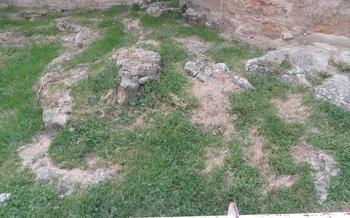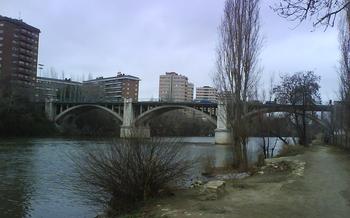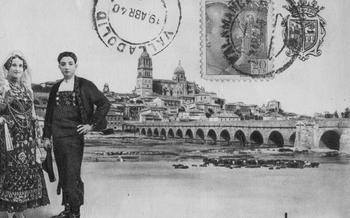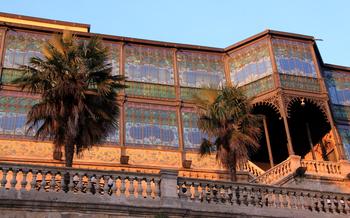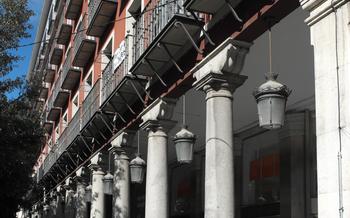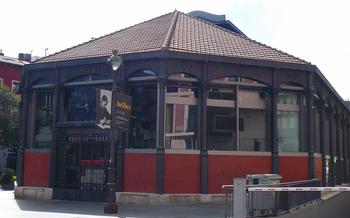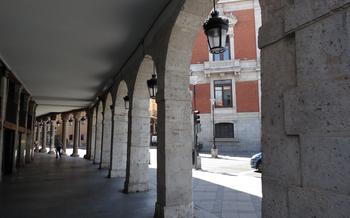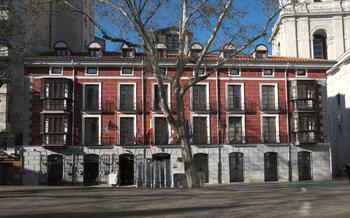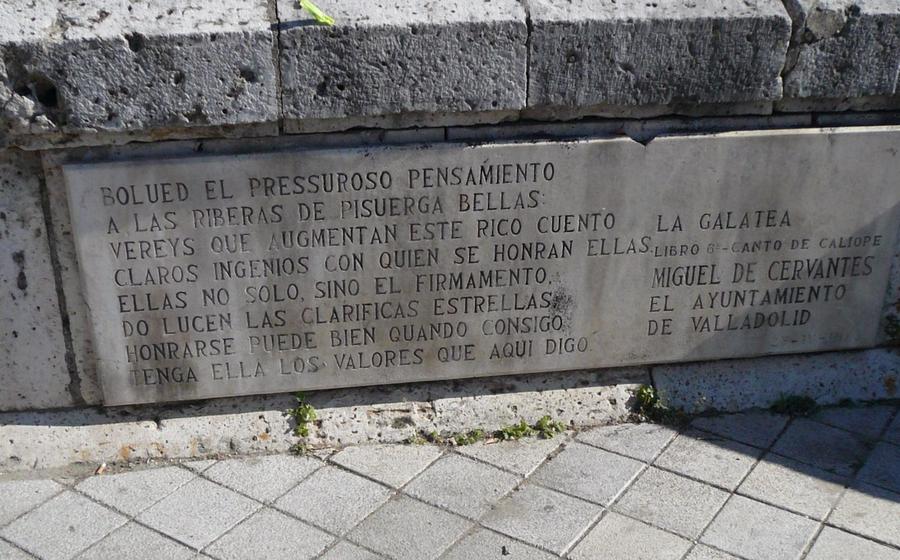
Puente Mayor
- Puente Mayor: A Historical Wonder
- Location and Accessibility
- A Stroll Along the Bridge
- Exploring the Surrounding Area
- The Legendary Statue of the Count
- The Bridge's Contribution to Local Culture
- A Symbol of Resilience
- Architectural Details and Design
- Unique Elements and Structural Ingenuity
- Historical Influences and Architectural Style
- Comparison with Other Bridges in Spain
- The Bridge's Role in Transportation
- The Bridge in Popular Culture
- The Bridge's Evolution Over Time
- Unique Photo Opportunities
- Insider Tip: Hidden Gems
Puente Mayor: A Historical Wonder
The Puente Mayor, majestically spanning the Pisuerga River in Valladolid, Spain, is an iconic symbol of the city's rich history and architectural prowess. Constructed in the 11th century as a vital crossing point, this bridge has stood the test of time, witnessing countless historical events and becoming an integral part of the city's identity. Its architectural significance lies in its unique design, featuring 15 semicircular arches that create a visually striking silhouette against the backdrop of the tranquil river. As a symbol of Valladolid's enduring spirit and resilience, the Puente Mayor stands as a testament to the city's ability to thrive amidst the tides of time and change.
An anecdote surrounding its construction adds to the bridge's charm. Legend has it that the initial attempt to build the bridge failed due to unforeseen circumstances. Undeterred, the builders sought the advice of a wise old woman who suggested they incorporate an egg into the mortar mixture. To their astonishment, this unorthodox solution proved successful, and the bridge was finally completed. This tale, passed down through generations, highlights the ingenuity and determination that went into the creation of this remarkable landmark.
Location and Accessibility
The Puente Mayor is conveniently situated in the heart of Valladolid, allowing for easy access by various means of transportation. Its exact address is Calle Puente Mayor, 47003 Valladolid, Spain. To reach the bridge, visitors can utilize the extensive public transportation network, with the closest bus stops being Plaza de Zorrilla (lines 1, 2, 3, 4, 8, 16, 18, and 19) and C/ Puente Mayor (lines 9 and 20). For those arriving by car, limited parking is available in the vicinity, although it's advisable to consider alternative parking options due to the bridge's central location. To avoid the peak tourist crowds and capture the serene essence of the bridge, an early morning or late afternoon visit is highly recommended.
A Stroll Along the Bridge
Stretching an impressive 140 meters in length and spanning a width of 11 meters, the Puente Mayor invites pedestrians to embark on a leisurely stroll, immersing themselves in the charm of Valladolid's past and present. The bridge offers captivating scenic views, allowing visitors to marvel at the city's iconic landmarks from a unique perspective. The majestic Cathedral of Valladolid, with its Gothic spires reaching towards the sky, dominates the skyline, while the vibrant Plaza Mayor, with its lively atmosphere and colorful buildings, adds a touch of modernity to the panorama. As you make your way across the bridge, keep an eye out for talented street performers or occasional events that bring the space to life, adding to the overall charm of this historic site.
Exploring the Surrounding Area
The Puente Mayor is situated in the heart of Valladolid, surrounded by a wealth of historical and cultural attractions. A leisurely stroll from the bridge will lead you to the Plaza Mayor, the city's main square, renowned for its stunning arcaded buildings and vibrant atmosphere. Here, you can soak in the local culture by visiting the Town Hall, the Teatro Zorrilla, or simply relax with a drink at one of the many outdoor cafés.
A short walk from the Plaza Mayor is the Valladolid Cathedral, a magnificent Gothic masterpiece that dominates the city's skyline. Its intricate facade, soaring spires, and awe-inspiring interiors are sure to leave you spellbound. Don't miss the opportunity to climb the bell tower for panoramic views of Valladolid and the surrounding countryside.
Art enthusiasts will delight in exploring the Museo Nacional de Escultura, which houses an impressive collection of religious sculptures from the Middle Ages to the Baroque period. The museum's exhibits provide a glimpse into the rich artistic heritage of Valladolid and Spain.
For those seeking retail therapy, the streets surrounding the Puente Mayor offer a variety of shopping options. From traditional Spanish crafts and souvenirs to international brands, there's something to suit every taste and budget. Be sure to visit the Mercado del Val, a vibrant indoor market where you can find fresh produce, local delicacies, and unique handmade items.
With its captivating history, architectural wonders, and vibrant atmosphere, the area surrounding the Puente Mayor is a treasure trove of experiences waiting to be discovered.
The Legendary Statue of the Count
Standing majestically upon the Puente Mayor, the statue of the Count of Ansúrez, or Pedro Ansúrez, is an iconic symbol of Valladolid. Cast in bronze, the statue depicts the legendary founder of the city, who is believed to have established Valladolid in the 11th century.
The statue holds a special place in the hearts of the people of Valladolid, serving as a reminder of their rich heritage and the city's origins. It stands as a tribute to the founder's vision and the city's enduring spirit.
According to local lore, the statue was initially intended to be placed in the Plaza Mayor, the main square of Valladolid. However, due to its size and weight, it proved impossible to transport it there. Instead, it was placed on the Puente Mayor, where it has stood proudly ever since.
The statue has become an integral part of the city's identity. It is often used as a meeting point, a place to celebrate victories, and a symbol of unity. Locals and visitors alike gather around the statue for various events and celebrations, honoring the legacy of the Count of Ansúrez and the spirit of Valladolid.
The Bridge's Contribution to Local Culture
The Puente Mayor is not just a historical landmark but also an integral part of Valladolid's cultural fabric. It serves as a stage for various festivals and events throughout the year, bringing the community together in celebration. One of the most notable events is the annual "Feria de Valladolid," a grand trade fair that transforms the bridge and its surroundings into a vibrant marketplace. Locals and tourists alike flock to the fair to experience the city's rich culture, indulge in local delicacies, and witness traditional performances.
The bridge also plays a significant role in local traditions and celebrations. During the annual "Semana Santa" (Holy Week), processions carrying religious floats wind their way across the bridge, creating a solemn and awe-inspiring spectacle. The bridge serves as a backdrop for these processions, adding to the spiritual significance of the occasion.
Beyond religious celebrations, the Puente Mayor has inspired artists and writers throughout history. Its imposing structure and historical significance have captured the imagination of poets, painters, and musicians, who have immortalized the bridge in their works. The bridge has become a symbol of Valladolid's resilience and beauty, inspiring countless artistic creations that celebrate the city's heritage.
As a meeting point, the Puente Mayor holds a special place in the hearts of Valladolid's residents. It's a place where friends gather, lovers stroll, and families come together to enjoy the river views and the lively atmosphere. The bridge has witnessed countless conversations, shared moments, and romantic encounters, becoming a symbol of human connection and community spirit.
A Symbol of Resilience
Throughout its existence, the Puente Mayor has borne witness to Valladolid's resilience in the face of adversity. During the Spanish Civil War, the bridge was heavily damaged, its structure scarred by the ravages of conflict. However, the people of Valladolid, steadfast in their determination to preserve their heritage, embarked on a meticulous restoration project, painstakingly returning the bridge to its former glory.
This restoration stands as a testament to the indomitable spirit of Valladolid, its refusal to bow to destruction. The Puente Mayor, once again resplendent in its reconstructed beauty, embodies the city's strength and unwavering commitment to its rich past.
Anecdote:
During the restoration of the Puente Mayor, a remarkable discovery was made. Hidden beneath layers of debris and damage, a small, intricately carved stone tablet was unearthed. Upon closer examination, it revealed a poignant message, etched by an unknown hand during the war. The inscription read: "Though battered and broken, we shall rise again." These words, a testament to the resilience of the human spirit, became a powerful symbol of hope and determination for the people of Valladolid.
Architectural Details and Design
Unique Elements and Structural Ingenuity
Puente Mayor stands out with its remarkable architectural features. It comprises 25 semi-circular arches of varying sizes, supported by sturdy piers that withstand the constant flow of the Pisuerga River. Each arch is meticulously crafted with granite voussoirs, radiating strength and precision. The bridge's overall structure showcases a harmonious blend of functionality and aesthetics. The sturdy stone construction ensures its longevity, while the elegant arches add a touch of grace to its imposing form.
Historical Influences and Architectural Style
Puente Mayor is a testament to the architectural influences that shaped Valladolid's history. The use of granite and semi-circular arches is reminiscent of Roman engineering, reflecting the enduring legacy of Roman rule in the region. The bridge also exhibits Gothic influences, evident in the pointed arches and decorative elements adorning its structure. This eclectic mix of architectural styles reflects the city's rich cultural heritage.
Comparison with Other Bridges in Spain
Puente Mayor holds its own among other renowned bridges in Spain. While it may not boast the grandeur of the Puente de Alcántara in Cáceres or the architectural complexity of the Puente de San Martín in Toledo, it stands as a unique and significant landmark in Valladolid. Its historic significance, architectural style, and symbolic value make it a beloved icon of the city.
The Bridge's Role in Transportation
Historically, the Puente Mayor served as a crucial crossing point over the Pisuerga River, enabling trade and travel between different parts of the region. It facilitated the movement of goods and people, contributing to the economic and social development of Valladolid. Today, the bridge continues to play a vital role in the city's transportation network, accommodating both vehicular and pedestrian traffic. Its strategic location facilitates the flow of traffic within the city center and connects it to neighboring areas. The bridge's enduring significance as a transportation hub underscores its importance to Valladolid's infrastructure and its role in shaping the city's urban landscape.
Anecdote:
In the early 20th century, a famous cycling race passed through Valladolid, and the Puente Mayor was a key part of the route. As the cyclists approached the bridge, a large crowd gathered to cheer them on. The atmosphere was electric as the riders crossed the bridge, their wheels humming against the cobblestones. The event showcased the bridge's significance as a symbol of Valladolid's sporting spirit and its role in connecting the city to major sporting events.
The Bridge in Popular Culture
The Puente Mayor has captured the attention of artists, filmmakers, and writers, becoming a symbol of Valladolid's rich cultural heritage. The bridge has graced the silver screen in several films, including the Spanish comedy "Ocho Apellidos Vascos" and the historical drama " Alatriste." Its striking silhouette has also been immortalized in paintings, poetry, and music, inspiring artists to create works that celebrate its beauty and historical significance.
In recent years, the bridge has become a popular tourist destination, thanks in part to its portrayal in popular culture. Tourists from around the world flock to Valladolid to see the bridge, drawn by its unique charm and historical significance. The bridge has also played a role in promoting tourism in the city, with postcards, posters, and souvenirs featuring its image.
The Bridge's Evolution Over Time
The Puente Mayor has undergone several transformations throughout its long history. In the 16th century, a flood damaged the bridge, necessitating extensive repairs. The bridge was also widened in the 18th century to accommodate increased traffic. In the 20th century, the bridge underwent a major restoration project that aimed to preserve its original appearance while modernizing its structure. The project involved reinforcing the bridge's foundations, replacing damaged stonework, and installing new lighting. The restoration was completed in 1998, and the bridge has since become a symbol of Valladolid's rich history and resilience.
Anecdote: During the restoration project, workers discovered a hidden chamber within the bridge's structure. Inside the chamber, they found a collection of ancient artifacts, including coins, pottery, and tools. These artifacts provided valuable insights into the bridge's construction and the lives of the people who built it.
Unique Photo Opportunities
The Puente Mayor presents ample chances to capture its allure through photography. With its unbeatable vantage points, you can frame the bridge against the backdrop of the city skyline, showcasing the harmony between history and modernity. The bridge's arches, especially when adorned with the golden hues of dawn or dusk, create a picturesque spectacle. For a different perspective, head to the riverbank beneath the bridge and capture the towering structure reflected in the tranquil waters.
To harness the bridge's full potential as a subject, consider experimenting with different angles and lenses. A wide-angle lens can accentuate the bridge's grandeur, while a telephoto lens can isolate its intricate details. Don't shy away from exploring various vantage points; sometimes, stepping back or getting closer can yield unexpected compositions.
Whether you're an experienced photographer or just starting out, the Puente Mayor offers a canvas for creativity. Embrace the opportunity to capture its essence, share your unique perspectives, and add to the visual narratives of this iconic landmark.
Insider Tip: Hidden Gems
Beyond the main attractions, there are hidden gems waiting to be discovered near the Puente Mayor. One such spot is the secluded garden of the Museo Patio Herreriano, offering tranquility amidst the city's bustle. Explore the narrow alleys of the historic Barrio de las Delicias neighborhood to uncover charming boutiques, art galleries, and traditional tapas bars.
For a unique souvenir, visit the nearby Mercado del Val, a vibrant market showcasing local crafts and artisanal products. And if you're lucky, you might stumble upon a hidden gem of an event, such as a pop-up market or a street art festival, that brings the bridge and its surroundings to life in unexpected ways.

